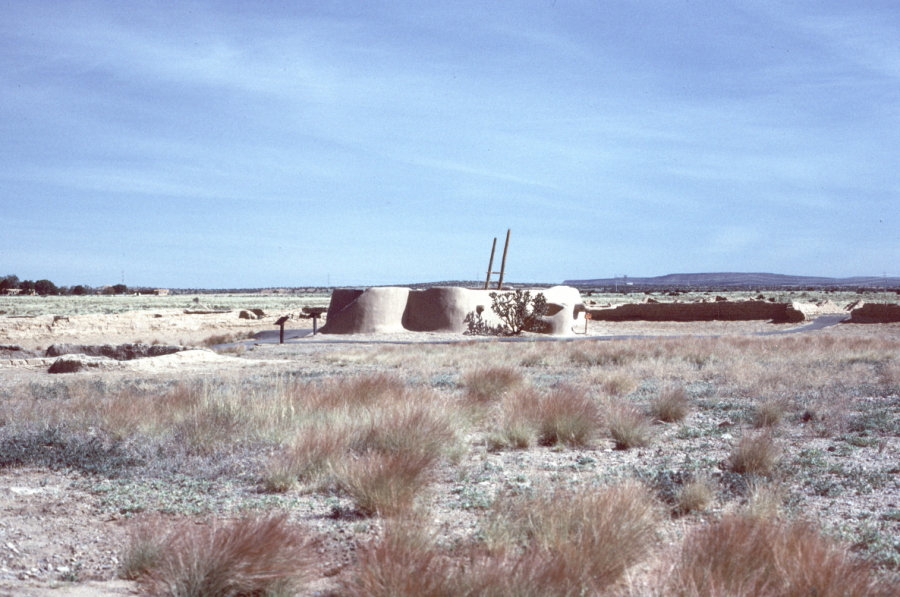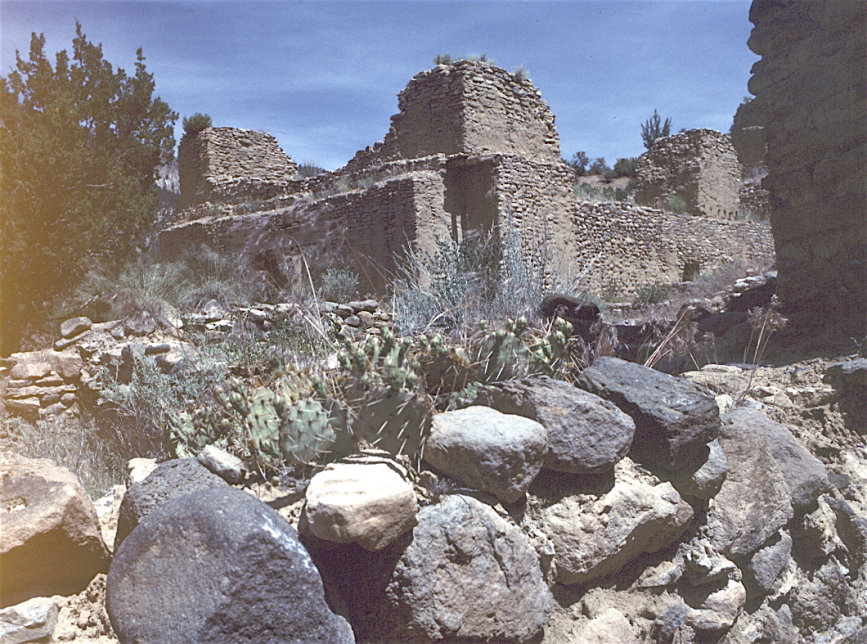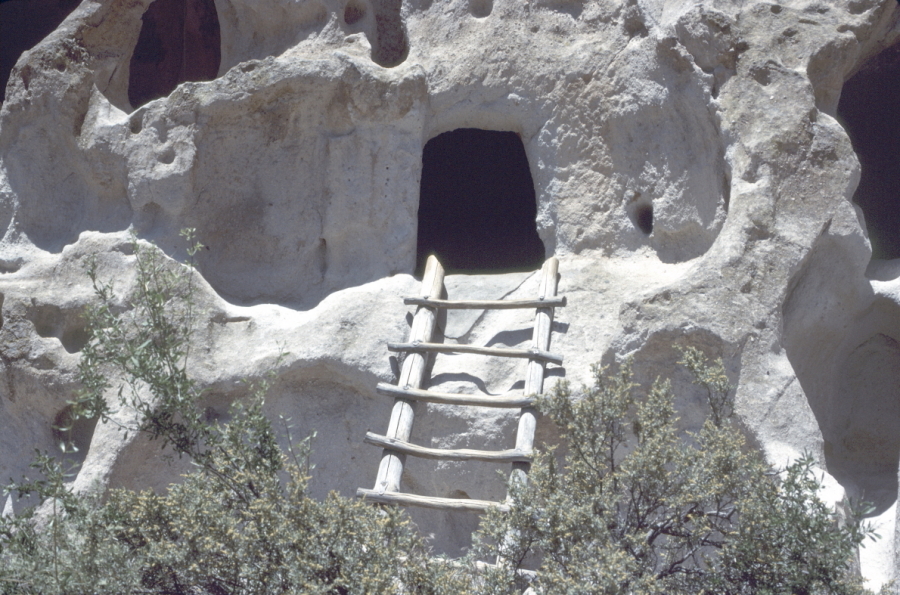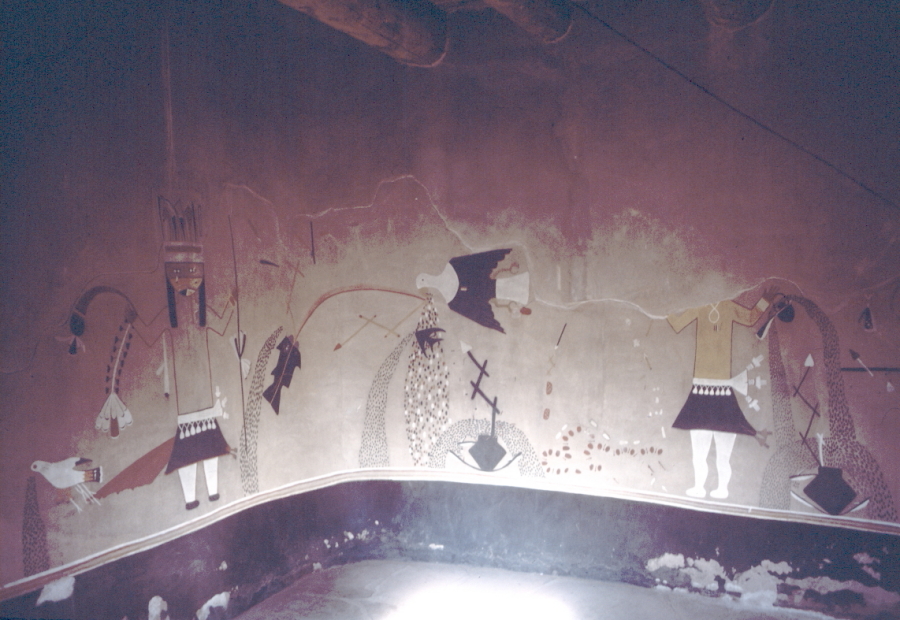Friday 17th June 1983
We have got ahead of our planned schedule and decide to take a leisurely day touring the Indian Pueblos. We set off early and arrive at the Coronado (State) Monument before it has opened, but this is of little consequence as admission is free and the visitors centre is closed for renovation.
The monument includes a ruined village, the Kuaua Pueblo. We can see adobe brick, (reconstructed) derelict walls of between 30cm and 1 metre tall marking the layout of what must once have been homes of a well organised village community. We read that following the excavation of the pueblo in the 1930s the original ruins were reburied to preserve them and the reconstruction was built to provide visitors with an outline of the original buildings. The information also indicates that typically the buildings would have had three storeys, some with only one storey but others reaching up to seven storeys. As this is the US I assume that includes the ground floor.
The walls show that the rooms were small but the Indians who lived here were thought to have few material possessions and at its height it was probably home to over 1000 people. Every pueblo had at least one kiva which is a round, underground room used by the men and boys for community and religious meetings, ceremonies and rituals. This pueblo still has an intact kiva and we climb down to see the inside. The wall is covered in murals but we discover that they are reproductions of one layer of the original. There had been several layers of original wall paintings, but they have been removed and transferred to a museum.

We leave Coronado and drive further up the Jemez Valley, passing other pueblos. We drive through Zia Pueblo, a current day indian village. Photography is not allowed, which for us amateur photographers is a bit disappointing, but a reasonable restriction to maintain respect for the residents given the number of snap happy tourists that must pass this way. The village buildings are made of the same red brick we have seen in the historic pueblos and they resemble the traditional designs, although here they are clearly newer and mostly appear to be single storey with much more space between them, presumably to cater for vehicle access.
We notice that in front of each group of buildings is a beehive shaped construction, charred with soot inside. We speculate that they may be kilns for firing the pottery, particularly as the artisan indian pottery is a major part of the tourist based economy. As we know the pueblos have been inhabited for hundreds of years we assume that there must be older parts but we decide not to stop to purchase pottery or to look for the more historic parts of the village.
The next stop on our itinerary is the Jemez State Monument. We find the site has ruins of another pueblo but also those of a Spanish mission post. The ruins of the church, the 17th century San José de los Jemez Mission Church, dominate the pueblo. Having now visited several indian pueblos without much information to explain what we have seen I decide to buy a book from the visitors centre, and I purchase one on the indian tribes of the south west, but quickly flicking through it does not throw much light on what we have seen. I will need to read it properly!

We quickly move on from Jemez State Monument and drive to Bandelier State Monument. We spend quite a long time at Bandalier walking the shorter, self guided trails which follow footpaths marked with numbered way points. We like the idea that each group of visitors is loaned a guide book (or leaflet) which describes the points of interest around the waymarked trails and which at the end of their tour they may either return or buy.
We follow a short trail which takes us to another ruined pueblo where we see the now familiar features of material, design and construction, but at this site there are also cave dwellings. Not all the local tribe lived in the pueblo buildings. Some lived in caves hewn into the sandstone rock faces. While exploring the trail we meet a group of Americans who recognise from our accents that we are English and they recommend we visit several other places of interest in the area.

Continuing on our tour round the pueblos we drive North to Taos. We stop in the town to purchase food but, reluctantly, we decide not to go to the pueblo itself. It is getting late and we are told that the best time to visit the pueblo is when the indians are holding their main festivals. Apparently most of the indians no longer live within the pueblo walls but nevertheless it would have been interesting to see a pueblo which is not just ruins. But time is pressing and tonight will be our first night camping. We need to buy our food, find a camp site and erect our tent before it is too dark.
We drive from Taos up into the mountains. The air gets cooler as we climb higher and when we find a camp site it is quite chilly. We are not really prepared for cold but we pitch the tent and then head into the village, a place called Red River - for a meal.
The village resembles an old fashioned town as seen in the old Westerns. It is primarily a winter ski resort although even now it is a lively place and advertising many activities. We choose a Texan steak house, done out like an old saloon bar, for our meal. While we wait we are given a bowl of peanuts for nibbling and quickly realise that the custom is to throw the shells onto the floor. We eat our meal and head back out into the cool night air to return to our tent. It was a good meal and the service was the best we have received so far on our trip.
Back in the tent we realise how ill equiped we are. We had not calculated the effect of altitude and, pushed for luggage allowance, we had been persuaded that in the heat of Arizona, New Mexico and Utah we would not need our heavy three season sleeping bags and so have with us only relatively thin cotton bags. We decide we need to sleep fully clothed and I pull on as many of my warmer clothes as I think will be comfortable. Stewart hasn't yet felt the cold as much as I have and puts on fewer extra clothes. Later in the night he wakes up cold and clambers around looking for more. As he fumbles to pull on extra clothes I convince myself that apart from my feet, which are freezing, I am quite comfortable and if Stewart asks I'll stick to that story because it was my idea to camp.
